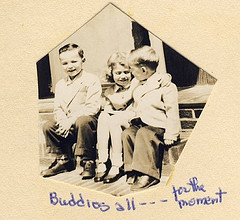Photos & Illustrations for a Family History Book: Sources and Choices
Biff Barnes
Digital printing has dramatically changed the look of family history books. Twenty years ago family history books were almost exclusively text, either prose written by their authors or charts and documents they had collected. Digital printing has made it possible to include photos and illustrations of all kinds and to do so in full color at a reasonable price. When you look at a newly published family history it is almost always an illustrated book. Creating illustrated books has raised some new issues for family historians. The most important are:
 Courtesy of Beth Scupham under Creative Comm
Courtesy of Beth Scupham under Creative Comm
- Choosing which illustrations to include
- Finding quality images for those illustrations
Let’s look at some ways to deal with both questions.
The first task is to sort through your own family photo collection to decide which are suitable for inclusion in your book.
- Use the best quality images available is a good general rule. If you have more than one image of a person, place or event, use the clearest, most interesting one scanned at the highest resolution.
- There’s one exception. Preservation trumps everything else. If you have a single photo of great grandmother it gets into the book even if it may be a bit damaged. A bit of work on Photoshop may improve it a bit, but whatever its limitations, preserving the photo takes priority.
- Finally, consider the relevance of the photo to the stories in the text. Maybe you need a head shot of a person whom you are describing. Maybe you have a photo that captures an event that you have included in the text. Or maybe you have a photo that tells an interesting story visually which can be completed with a brief caption and doesn’t need to be included in the text.
What happens if you decide that you want to supplement you family photos. Maybe you don’t have a picture of an ancestor and want to find one. Maybe you are unable to find pictures of ancestors and decide to use pictures of places and times in which they lived. Maybe you decide to use images of historical events to add context to the family history. Where do you find those images?
The internet offers a wealth of images if you know where to look. Collections of universities, libraries, historical societies and genealogical societies are increasingly available online.
My favorite general search sites for images of ancestors include
- Ancestor Search is a site which gives you the opportunity to search eight photo databases on a single page.
- The Photo Center at MyHeritage.com offers the opportunity to find old photographs. You can also help others by sharing your old family photos on the site.
If you are looking for photos for historical context or to provide a sense of place try:
- Best Historical Photo Databases.at Family Tree Magazine
- Best History Sites The site was set up for teachers but has links to some excellent photo collections
- Criticalpast.com CriticalPast is one of the world’s largest sources for archival footage including 57,000 videos and over 7 million images.
The issue to be aware of is that some of the images you find on the web are of a quality not suitable for publication. We have produced a video to help you evaluate image quality and find images that are of the quality you’ll need for your book. You can see it on our post Use Google Image Search to Find Quality Images for Your Book.
Attention to providing quality images to illustrate your family history book will help you engage your readers, particularly the younger ones used to the brilliant colors of high definition TV and the internet.